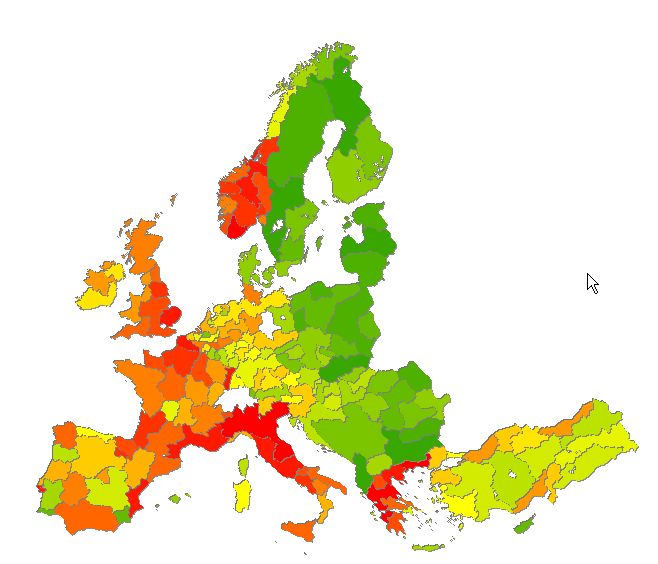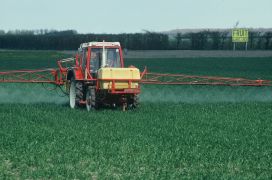Supply module
Overview

The supply module comprises about 50 crop and animal activities for each of the around 280 regions (at the so-called NUTS-2 level covering EU27, Norway, Western Balkans and Turkey) or about 2500 farm type models for EU27 (the remaining regions continue to operate at regional level), and includes about 50 inputs and outputs. Each independent model maximises regional agricultural income at given prices and subsidies, subject to constraints on land, policy variables and feed und plant nutrient requirements in each region.
Income is defined as the gross value added (GVA) at producer prices plus direct subsidies (premiums). Costs neither included in the GVA nor covered by the restrictions in the NLP models are captured by a quadratic cost function.
Feed requirements for each animal comprise energy and crude protein as equality constraints, and a corridor for a dry matter. For ruminants, different fibre restrictions are added. The requirement are met by chosing a cost minimal feed mix based on 10 types of feedingstuff, which comprise 5 types of non-marketable fodder and 5 types of concentrates. The mix is further steered by minimum and maximum bounds for the feedingstuff and a quadratic cost function depending on the feed input coefficients which allows for interior solutions and a smooth response to price changes.
Most crop activities features a higher and lower intensive variant to allow for endogenous yield adjustments. Yields and yield depending inpust are also updated based on price elasticities
Since winter 2009/2010, CAPRI comprises a land supply curve which depends on the marginal return to land from the agricultural sector in each region respectively farm type. Further on, substitution between permanent grass land and arable land was added. Before, grass land and arable land were two fixed endowment.
The module ist based on a template approach: the models for each region are structurally identically, i.e. the comprise the same equations and variables, and differences between the regions are expressed in parameters. That allows an efficient uniform handling of the models and their results.
Model calibration and simulation response
The simulation response of the models depends on the interplay of the contraints and the objective function. Given the relatively small number of contraints directly impacting on the allocation of the production activities, the simulation response is too a large extent depending on the parametrization of the quadratic terms of the cost function.
The slope terms of the cost function are either estimated from time series analysis (Jansson 2007) or derived from exogenous elasticities. The models may hence be seen as a kind of hybrid approach combining features from traditional programming models with dual econometric estimation (see also Heckelei 2002). The cost functions' constant terms let the models calibrate to a given vector of technical coefficients, levels of the production activities, prices and subsidies. One set of parameters is generated to let the regional models calibrate to a three-year average around the base year, another to ensure calibration to the reference run.
Environmental indicators and restrictions
From the input coefficients and activity levels, different environmental indicators can be derived such as nutrient balances or gaseous emissions. Part of the these indicators had been also embedded in constraints to e.g. allow for modeling a trading scheme for agricultural Green House Gas emissions.
Integration in overall modelling system
The regional programming models steer the supply response and too a large extent the feed demand for the countries covered by them in the overall modelling system, whereas the prices are determined in the market module. A point estimate of the Jacobian matrix of the frist order activity level equations from the regional models is used to parametrize the supply response for the countries covered by the regional models, ensuring a similar supply response.
In each iteration between the supply and market modules, the supply and feed demand equations in the market module are shifted as to match at prices in the current simulation the response from the regional models. The price changes from the market are used to update yields and related input coefficients.
The results of the regional models are input a post-model analysis to determine different economic and environmental indicators. They are also spatially downscaled to 1x1 km grid cell clusters for EU27 to allow for spatially explicite environmental analysis.
Data
The ex-post data for the supply part (hectares of crops, animal herds, yields) are taken mainly from EUROSTAT's REGIO domain. Data are consolidated to match national statistics, and missing ones are estimated from time series and/or national ones. The national data are maintained and updated together with the CAPSIM model by a module called CoCo (Completeness and Consistentency).
Input coefficients per activity and region are estimated as to exhaust the national sectoral costs shown in the Economic Account for Agriculture, while coming close to the Standard Gross Margins published by European Commission. The estimates are differently derived for feed input coefficients, fertilizer input coefficients and the remaining inputs. The set of requirement constraints discussed above is simulaneouly adjusted during the estimation of the feed input coefficients to define a plausible mix in the base year which exhaust both regional fodder availability and the feed quantities for marketable products found in national market balances. Crop specific regional fertilizer application rates draw on national expert survey on typical fertilization doses, regional organic nutrient availability and crop retention estimated from crop yields. For the remaining input coefficients, econometrically derived estimates from FADN are used.
Technical realisation
As the rest of the CAPRI modelling system, the supply model is realised in GAMS and solved with the non-linear solver CONOPT developed by Arne Drud. Several GAMS processes are spawned in parallel to regional models in parallel, which allows to solve all 280 regions on a powerful eight-processor machiune in about 8 seconds and the close to 1900 farm type models in 45 seconds.



